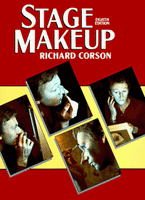
How to Be a... | How To's | Local Industry
How to Be a Makeup Artist
Written by Kristen Paulson | Posted by: Anonymous
Remember that scene in "Mrs. Doubtfire" where Robin Williams shows up at his brother’s door ready to be transformed into a woman? This is the power that makeup artist Joe Rossi wields so keep reading because so can you.
Getting Started
Joe Rossi began his 20-year career in the late 70’s doing theater makeup at Rhode Island College in Providence, which is affiliated with the prestigious Trinity Repertory Company (http://trinityrep.com). As a student, I wonder if he knew that he’d later be teaching theatrical makeup at Emerson, Boston University, and Salve Regina University?
An art education major, he taught art for a year before becoming a makeup artist. Obviously, making the leap from painting canvases to faces wasn’t too much of a stretch. If you’re interested in the trade, be prepared to work long hours — Joe works a "regular 80-hour week," as he laughingly describes it.
Of course, he can afford to laugh. When fatigue sets in, he can expertly camouflage his bags. A sense of humor will be a useful tool for the beginner since there are no direct routes to success. In the good old days, you could get work by apprenticing in a studio like MGM or Universal. Unfortunately, film companies no longer maintain studios. Further, there are no great masters (like Yoda for the Jedi) to train young students in the makeup arts. Except for Joe.
In this guerilla career environment, he has the following gentle suggestions:
1. Choose your category and style.
Does the idea of making someone look like Yoda (character makeup) excite you or would you prefer making Deborah Norville look flawless? If you answered "yes" to the latter, try TV. Do you cherish your tattered copies of W (high fashion makeup)? Perhaps high fashion is for you. Shakespeare buff? Theatre may be the rub.
2. Network.
It’s crucial to forge positive connections so meet as many makeup artists as possible. If you are talented and work hard, people will recommend you and you’ll be on your way (see number 3).
3. Help other makeup people.
Remember how you mother told you to play nice? Lending your support will open doors.
4. Travel. This one’s a real hardship. We feel for you.
Develop your reputation in a bigger market. Joe spent three years in New York, which boosted his career. Starting out, he didn’t think he’d find success in the New England market since the New York and California markets are larger. Happily, he was wrong. Would you believe the biggest market is Minneapolis, MN, where TV stations have staff makeup artists? Hate the cold? Book a ticket to LA and you’re on your way.
5. Join up.
Solidarity is important, so you may want to join the Local 798, based out of New York (I.A.T.S.E.), which encompasses almost all of the film crafts.
6. "Stage Makeup" — buy this book. It may be prove more valuable than Great Lash.
Written by Richard Corson, it is the makeup artist’s bible. Recently released in its ninth edition, it’s available at amazon.com. Keep it on your nightstand for handy reference. Flipping through, you may notice that Joe wrote the chapter on film and TV makeup, which was absent in previous editions. A cool full-circle factoid: Joe used it when he was a novice and contributed to the book later as a pro.
Challenges and Perks
Joe runs his full-service makeup business, Joe Rossi & Company in addition to working on-site. He does beauty and special effects makeup for TV and film and some theatrical work for a Boston and Rhode Island clientele.
Joe cites variety as one of the greatest joys of his métier. Since he doesn’t limit himself to doing just one kind of makeup, such as for soap operas, each day is a new adventure. He also enjoys his relationships with the talent and film crew. Remember the gaffers in November’s issue? They and the camera department are the makeup person’s closest collaborators. Together, they ensure that the face is properly lit for a scene. Sometimes the lighting people may have one plan and the makeup artist a conflicting need. Collaboration between lighting and makeup is the key to success.
Mixing with celebrities and Presidents is fun too. In fact, Joe found President Clinton "Very accessible as a president and very cool to work with." In his experience, politicians are afraid they’ll look made-up on camera, since they’re unaccustomed to wearing makeup. After all, for TV makeup, there are no second chances. Joe cites the worst-case scenario of the first presidential debate. Gore’s makeup was overdone, resulting in bad publicity for the candidate as well as the makeup artist.
In contrast, makeup for print is less risky since it can be retouched—and makeup for film or TV is more difficult since it can’t be. Film makeup would not supply enough "coverage" (read: spackle) for TV, which requires a lot more makeup. A truly good makeup artist will grasp this distinction. Fortunately, film work is more forgiving since makeup can be tested by setting and lighting a scene for makeup and wardrobe to see how they’ll look. "It’s a luxury because it costs an extra shooting day," Joe says. However, it’s a good practice where possible, so everyone can feel confident about the outcome.
In terms of the actual medium, which products will be the lightning rods of your genius? In the old days there was only Max Factor. Now there are multitudes of products at your disposal. Joe’s favorite is Mehron (http://www.mehron.com/), a line exclusive to film, TV, and theater. Often he has to use department store product lines like MAC, Lancôme or Christian Dior, due to a star’s requirements. Reports Joe, "Ninety percent say to do whatever, 10 percent bring their own products. Thanks to universal product lines, I can usually use something from my own kit."
Burning Questions and Workaday Challenges
Is there an actor alive who is so stunningly radiant they don’t need a drop of makeup?
Joe reassured me that "everybody needs something." In fact, since actors are often sleep-deprived, at some point even the best skin will break out. This brings us to one of the largest challenges in film, aside from marshalling the necessary makeup talent—continuity. Joe cites the example of "Outside Providence," for which he was head of the makeup department. It starred many teenage actors (makeup artist translation: BREAKOUTS). The director wanted a very natural 70’s look, so he asked Joe to "leave the blemishes." Joe then encountered a dilemma: Keep them covered throughout and he’d have the best continuity. If he left them alone they’d eventually heal and he’d have to put them back in so later scenes would match earlier ones.
This problem extends to how hair is positioned, the amount of lipstick and eyeliner, and sequence. To illustrate, "State and Main" shot a scene in a Needham, MA hotel room. The outside of the hotel was shot in Manchester-by-the-Sea, MA. The scenes weren’t even shot the same day. Since movies must appear seamless, Joe used photos taken earlier as reference to recreate the earlier scene, working to achieve continuity. It takes years of expertise to develop this level of skill, but it’s a valuable investment since, in Joe’s opinion, it separates the true professional from someone who just "does makeup."










